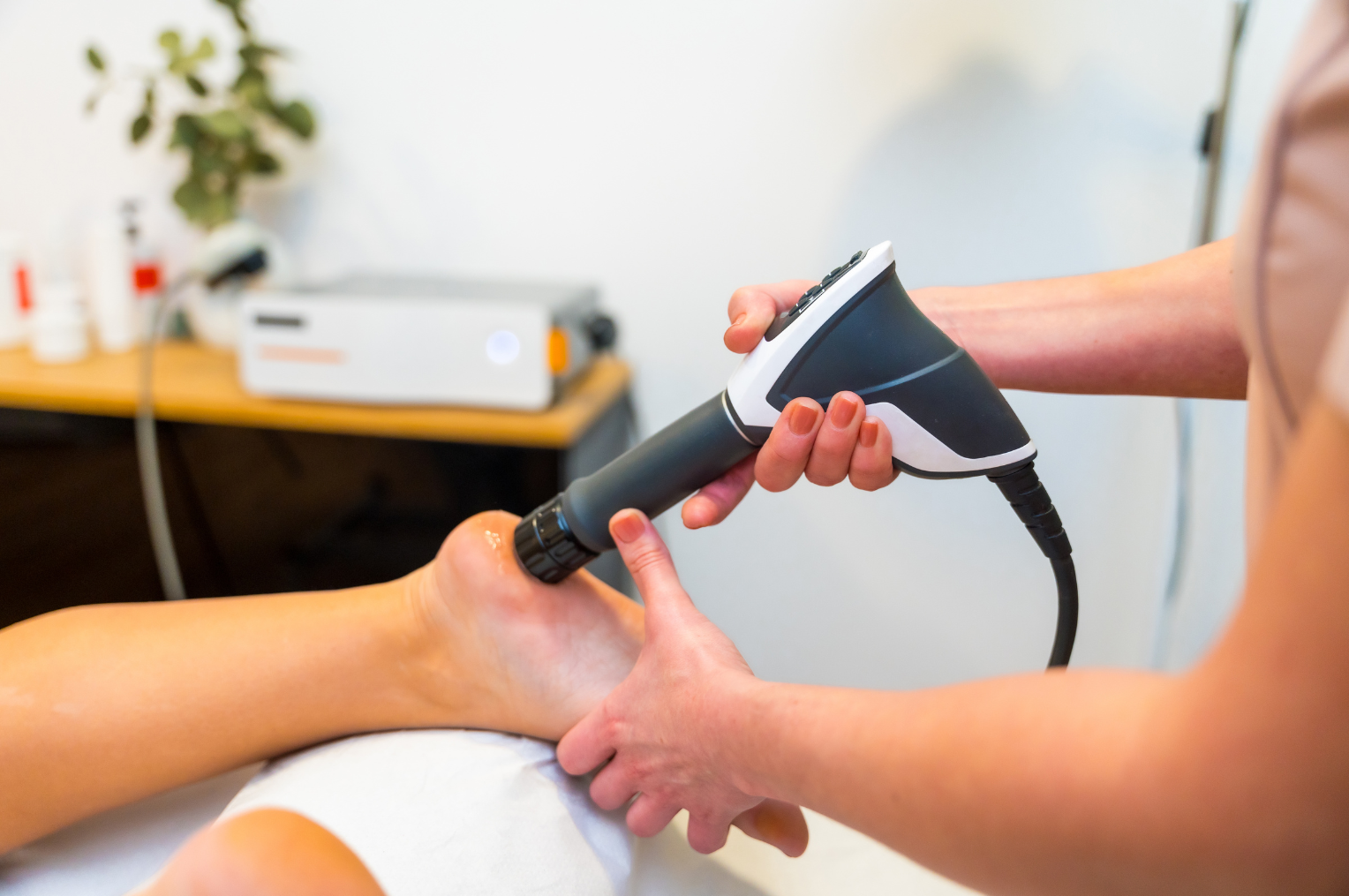

Foot and heel pain, especially in the form of conditions such as plantar fasciitis, can be debilitating and significantly impact a
person’s daily life. Heel pain is one of our specialities here at Perform Podiatry, and we offer innovative treatments to support your
recovery in ways that many clinics don’t have on offer: with the addition of Low-Level
Laser Therapy (LLLT)
and Shockwave Therapy
as part of your overall management plan.
Both shockwave and laser therapy offer unique benefits, and can be used to enhance and optimise treatment outcomes, depending on your specific needs and circumstances. Here’s a look into whether these therapies may help you get the results you want in the shortest timeframe.
Laser therapy uses low-intensity laser light to stimulate healing in the body. The specific laser we use, called the Nu-Tek laser, emits a precise kind of light that penetrates the skin and underlying tissues. This light is monochromatic, coherent, and polarised, meaning it is focused and aligned in one direction, which maximises your benefits.
We’ve detailed everything you need to know about the low-level laser here, but to sum it up, when the laser light (which is produced by the device at a very specific beneficial wavelength) reaches the tissues, it triggers a series of beneficial biological processes. These include helping improve blood flow and enhancing the delivery of oxygen and nutrients to damaged tissues. These actions speed up the natural healing process. Additionally, laser light stimulates the growth of new blood vessels (angiogenesis), boosts enzyme activity, and alters the levels of various chemicals and hormones in the body to reduce pain and inflammation - which is why many people notice a reduction in pain from the first session.
Laser therapy offers several significant benefits:
Shockwave therapy involves the application of high-energy sound waves (referred to as ‘shockwaves’) to an injured area. These shockwaves are generated by a handheld device placed strategically over the skin (so it stays non-invasive), with the waves penetrating the tissues to stimulate healing. We’ve detailed everything you need to know about shockwave therapy here.
When the shockwaves penetrate down into the tissues, they create microtrauma (controlled damage) in the targeted tissues. This stimulates the body's natural healing processes by increasing blood flow, breaking down scar tissue, and promoting the regeneration of tendons and other soft tissues. The therapy also triggers the release of growth factors and the formation of new blood vessels, enhancing the repair and healing of tissues. Simply put, your body repairs better and faster.
Shockwave provides several key advantages:
When deciding between shockwave therapy or laser treatment and which could be best for your pain or injury, there are a few things to consider:
The mechanism of action of the device
Laser uses light energy to penetrate tissues, reduce inflammation, and promote cell regeneration. It is particularly beneficial for acute inflammation and pain in conditions like plantar fasciitis and Achilles tendinopathy, among other chronic conditions, including arthritis. On the other hand, shockwave uses mechanical sound waves to break down scar tissue, increase blood flow, and stimulate healing processes. It is highly effective for treating tendon and ligament injuries, specifically longstanding injuries, such as Achilles tendinopathy, and conditions involving calcification.
The treatment experience
Laser therapy is painless and can be used frequently with no known side effects, making it a gentle option for patients with low pain tolerance. Shockwave may cause mild discomfort during treatment, but it has great benefits, such as faster results, and usually requires fewer sessions.
Effectiveness
Laser therapy is effective for reducing pain and inflammation, both in acute and chronic conditions. It is becoming a go-to for the time frame immediately following an injury, too, helping our patients manage their injury process much more comfortably. Its gentle approach is also suitable for patients where some minor discomfort may be a factor or deterrent to treatment. Shockwave therapy is proven to be highly effective for conditions involving calcification and chronic (ongoing) tendinopathy. It shows quicker results in reducing pain and improving function in these cases.
Thankfully, the choice between laser therapy and shockwave isn’t one that you have to make on your own. At your first appointment, your podiatrist will discuss your available treatment options (which will depend on your specific condition, your circumstances, goals and the like) and whether shockwave, laser, or both may be an option. You’ll have plenty of time to ask questions, and get the information you need to make the best decision, including what your podiatrist would recommend.
Generally speaking, for acute inflammation and pain, laser is a gentle and effective option. For tendon and ligament injuries or conditions involving calcification, including longstanding injuries, shockwave may provide faster and more significant relief.
Still trying to figure out where to start with getting relief from foot and heel pain? Book with our podiatry team by following
our online booking system,
or give us a call at (09) 523 2333 and speak with our receptionist team. We’re here to help.

If you’re unsure whether you should wear walking or running shoes when exercising, this article is for you.
We explain the differences between walking and running shoes and how to determine which one is best for your feet. When it comes to buying a new pair of shoes, most people walk into a store expecting to just “find something comfy.” Then, suddenly, you’re asked: Are you looking for
walking shoes or running shoes? And that’s where the confusion begins. Because for many people, the answer isn’t that simple.
You could walk a lot – to work, around the block, chasing after the kids, or while catching up with friends. You could have also just joined
a gym or registered for the Couch to 5km. Or you could be a walker who just wants the option to go for a run if the mood strikes. So, which
shoe do you pick?

Discover why foot health is so important as we age and how Perform Podiatry supports seniors in staying mobile, independent, and pain-free. From diabetic care to personalised treatment plans, we’re here to help keep your feet happy and healthy, every step of the way.

Discover how Class IV Laser Therapy at Perform Podiatry offers powerful, drug-free relief for foot and ankle pain. Backed by science, this advanced treatment helps you heal faster and move better, without the need for surgery or medication.
Keeping your family on their feet and helping them to walk, run, play and exceed their goals is why we love getting up in the morning.
Ground Floor, One Health Building
122 Remuera Rd, Remuera
Auckland 1050, New Zealand
| MON - FRI | 7:30am – 6:30pm |
| SAT | 8:30am – 4:30pm |
| SUN | Some availability |
Make an Appointment
Online Schedule
Our virtual receptionist is available 24/7 to help with general questions, booking requests, and clinic information, even when our team is busy, or it's after hours.
Whether you're calling us or using our website, you'll get fast assistance any time of day. And if your query needs a personal touch, a member of our team will follow up as soon as possible.